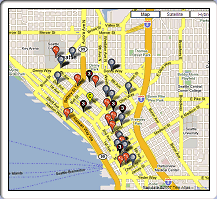Under the auspices of the IEEE 802.3 Working Group, Ethernet has developed into one of the most widely deployed networking technologies in the world. Ethernet’s unrelenting advances have allowed it to become the dominant technology for Enterprise networking. Data rates have increased from 10Mbps to Gigabit speeds. Links have gone from half to full duplex. Link aggregation and flow control have added functionality to the standard. Other groups within IEEE 802 have also contributed significantly to the development of Ethernet. MAC Bridging (IEEE 802.1D), Virtual LAN technology (IEEE 802.1Q) and Class of Service definitions (IEEE 802.1p) have all been instrumental in the continued dominance of Ethernet in Local Area Networks. Now the work of the 802.3ae 10 Gigabit Task Force will again bring Ethernet into another generation of applications.
Ethernet interfaces are being added to equipment that previously never had them. Many of these ports will be used for transporting Ethernet packets in WAN and MAN environments. Some will put Ethernet packets onto traditional SONET infrastructures. Others will provide Ethernet service interfaces on DWDM equipment. Cable modem equipment and DSL aggregation devices are now often deployed with Ethernet interfaces. This suggests that there will be significant Ethernet traffic in the WAN and MAN as well as the LAN.
If you are a carrier or multi-location enterprise and are interested in Ethernet WAN or MAN services, WDM (Wave Division Multiplexing) or low latency fiber routes, please contact us.
Other developments within IEEE 802 suggest that 10Gbps Ethernet will be an important WAN/MAN technology. Efforts in the IEEE 802.1 and IEEE 802.17 Working Groups will also promote the greater worldwide deployment of Ethernet. The IEEE 802.17 Working Group, also known as the Resilient Packet Ring (RPR) Working Group, will use some of the 10Gbps Ethernet components specified by the IEEE 802.3ae Task Force, as a foundation of the RPR protocol. It is another example of the IEEE 802 groups working in parallel to develop complementary standards. This paper is designed to highlight how the IEEE 802.17 RPR Working Group draft plans to make use of Ethernet components.
Existing Solutions for Metro Networks
Resilient Packet Ring (RPR) systems arose from metro carriers’ need to efficiently and reliably carry packet traffic on fiber rings, the dominant topology in the metro environment. The incumbent carrier metro infrastructure is based on SONET/ SDH, a technology and architecture optimized for voice circuit—not packet—traffic. Hence, in an environment of accelerating packet traffic growth there is a less efficient use of fiber resources due to the disparity between the bursty nature of packet traffic and the fixed circuit nature of SONET/SDH.
Transporting packets across a shared medium is a problem typically handled at the MAC (Media Access Control) layer of a protocol stack. By controlling access to the medium, a 10Gbps optical ring, for example, and arbitrating requests for its use, the MAC layer is able to guarantee service quality (i.e., delay and jitter) and provide bandwidth management. Using this new MAC, RPR systems will provide the rapid restoration, managed bandwidth, and bounded latency and jitter that carriers request in their packet edge networks.
RPR: A New MAC for Metro Transport Networks
Resilient packet ring (RPR) is an emerging network architecture and technology designed to meet the requirements of a packet-based metropolitan area network. An RPR network is a ring-based architecture that consists of packet switching nodes connecting to adjacent nodes over a single fiber pair. The network topology is based on dual counter-rotating rings. Inter-nodal links are fiber-based and may employ WDM to scale the capacity of the ring.
The IEEE 802.17 Working Group was created in 2000 and is responsible for the development of a new MAC protocol within the 802 architecture. Systems built around this protocol are called Resilient Packet Ring (RPR) systems. In March of 2001 the 802.17 Working Group passed motions that require the RPR MAC to be payload and PHY agnostic, and to support SONET/SDH and 1Gbps and 10Gbps IEEE 802.3 physical layers. With these votes the working group signaled its desire to leverage the work of prior standards groups in defining physical layers (PHYs). The 802.17 Working Group will define the interfaces that make the 802.17 MAC compatible with other existing IEEE standards-based PHY components, in particular the work being completed by the IEEE 802.3ae Task Force.
The use of existing PHY components is important for several reasons. The benefits of the 802.17 draft standard arise from the behavior of the Layer 2 RPR MAC protocol the working group is creating. The 802.17 draft standard can be developed more rapidly without the requirement to develop new PHY layers. Rapid progress on the standard helps ensure that it reaches the market in a timely manner. Secondly, the use of existing standards-based PHY components takes advantage of cost economies that those components enjoy. This lowers capital expenditure requirements and is a primary goal of most carriers looking to implement the 802.17 architecture.
However, the planned use of standard Ethernet PHY components has created some confusion regarding the interface requirements for RPR switches that use Ethernet PHYs versus Ethernet switches using the same PHYs. Below is a description of some of the PHY layer objectives of the 802.17 Working Group with the goal of clarifying the similarities and differences between the 10Gbps 802.17 and the 10Gbps 802.3ae draft specifications.
The IEEE 802.3ae draft standard is scheduled for completion in 2002. It includes the following sublayers that may be referenced by the 802.17 Working Group in their document.
Reconciliation Sublayer (RS) and 10Gbps Media Independent Interface (XGMII) – This is the reconciliation sublayer specific to the 802.3 MAC-PLS (physical layer signaling) interface, and an optional 10 Gbps electrical interface.
- XGMII Extender Sublayer and 10Gbps Attachment Unit Interface (XAUI) – This is an optional extension for the XGMII allowing longer distances and lower device pin-counts.
- PHY – This sublayer includes the Physical Coding Sublayer (PCS), the optional WAN Interface Sublayer (WIS), the Physical Medium Attachment (PMA) sublayer and the Physical Medium Dependent (PMD) sublayer. A total of seven port types are specified. Four are “LAN” PHYs, operating at a data rate of 10.0 Gbps, and three are “WAN” PHYs, operating at a data rate and format compatible with SONET STS-192c/SDH VC-4-64c.
- Medium Dependent Interface (MDI) – not specifically defined.
 RPR Requirements (802.17)
RPR Requirements (802.17)
The 802.17 Working Group intends to support all the draft 802.3ae sublayers and interfaces described above with no changes, with the exception of the Reconciliation Sublayer (RS). The 802.17 Working Group is likely to define a new MAC to Physical Layer interface, similar to the 802.3 MAC-PLS interface, which will be needed to support the various types of PHYs used for RPR. A new RS will be needed to adapt this logical MAC-PHY interface to the 802.3ae XGMII electrical interface.
The 802.17 RS is likely to perform many of the same functions as the 802.3 RS. It converts logical service primitives to and from electrical signals at the XGMII. The RS maps the first octet of the Preamble field to a Start control character, and aligns it to lane 0 on the XGMII. It maps a Terminate control character as the first octet of the Inter-Packet Gap (IPG) following a frame. Additionally, the 802.17 RS maps a logical RPR MAC frame to a format compatible with the Ethernet physical frame format. The proposed 802.17 MAC may not generate inter-frame spacing, so the RS would be required to insert an IPG between frames.
Conclusion
As the RPR draft specification is PHY agnostic, some implementations will leverage the 802.3 PHYs. Using the Reconciliation Layer as a means to convert logical RPR frames into Ethernet-compatible formats ensures that the PHY layer components from Ethernet are available for use unchanged in RPR systems. While this will provide cost and time-tomarket benefits to RPR systems, the RPR frames are not compatible with the 802.3 Ethernet MAC, and will not interoperate directly with that equipment.
Both Ethernet switches and RPR systems are capable of transporting Ethernet services. There is widespread agreement that Ethernet services will be the next significant service offering by many service providers. Ethernet PHYs for RPR will play an important roll in the development of these offerings.
Glossary
Local Area Network (LAN):
[adapted from IEEE 100 (C/DIS) 1278.2-1995, 1278.3-19961 ] A communications network designed for a user premises, typically not exceeding a few kilometers in length, and characterized by moderate to high data transmission rates, low delay, and low bit error rates.
Logical Link Control (LLC) Sublayer:
[C/LM 8802-5-1992s] That part of the data link layer that supports media independent data link functions, and uses the services of the MAC sublayer to provide services to the network layer.
MAC Client:
The protocol layer (or sublayer) immediately above the MAC sublayer. Generally, the network layer or logical link control (LLC) sublayer.
Medium Access Control (MAC) Sublayer:
(1) [IEEE 100 (C/LM) 8802-5-1995] The portion of the data link sublayer that controls and mediates the access to the ring.
(2) [802.3-2000 1.4.167] The data link sublayer that is responsible for transferring data to and from the physical layer2 .
(3)[ISO/IEC 15802-1] The MAC service provider.
Medium Access Control (MAC) Sublayer:
(1) [IEEE 100 (C/LM) 8802-5-1995] The portion of the data link sublayer that controls and mediates the access to the ring.
(2) [802.3-2000 1.4.167] The data link sublayer that is responsible for transferring data to and from the physical layer3 . (3)
[ISO/IEC 15802-1] The MAC service provider.
Metropolitan Area Network (MAN):
A network interconnecting individual stations and/or LANs, and spanning an area typically occupied by a city. Note: A MAN generally operates at a higher speed than the networks interconnected and crosses network|
administrative boundaries.
Physical Layer (PHY):
[(C/LM) 8802-5-1995] The layer responsible for interfacing with the transmission medium. This includes conditioning signals received from the MAC for transmitting to the medium and processing signals received from the medium for sending to the MAC.
Resilient Packet Ring (RPR):
(1) A connectionless ring-based MAC protocol to be defined by IEEE 802.17, appropriate for LAN, MAN, or RAN 4 deployment5 .
(2) A collection of stations conforming to the resilient packet ring protocol, and the links forming the ring
Wide Area Network (WAN):
[IEEE 100 (C/DIS) 1278.2-1995] A communications network designed for large geographic areas. Sometimes called long-haul network.
Links of interest:
- Ethernet Whitepapers
- USA Business & Carrier Metro Ethernet
- Metro Wave Division Multiplexing, DWDM Services and DWDM/ROADM
- Business Phone Systems (external)
- International WAN & DIA Services
- Wholesale SIP Termination (carrier & enterprise)
If you found this page helpful, please support us by bookmarking us with one of the services below or by linking to this page.
- ethernet physical layer
- reconciliation layer
- application of 802 17 rpr
- RECONCILLIATION 802 3
- resilient packet ring working and manufacture
- resilinet packet ring metro
- Ring wide area network
- sdh vc map
- sublayers of medium access control
- use of ethernet phy
No related posts.










